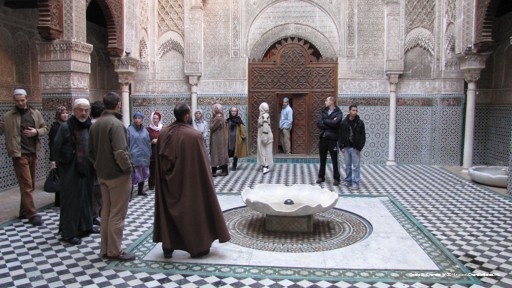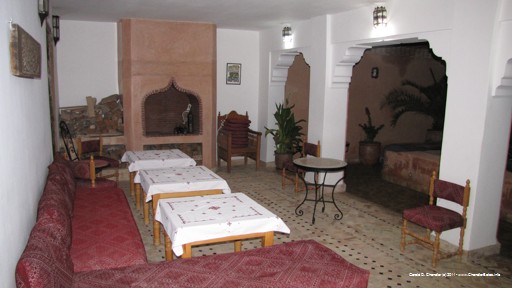Front Page | Home | Blog | Index | Site Map | Contact
![]() Marrakesh
Marrakesh
![]() Essaouira
Essaouira
![]() Casablanca
Casablanca
![]() Rabat / Sale
Rabat / Sale
![]() Chefchaouen
Chefchaouen
![]() Fez
Fez
![]() Meknes
Meknes
![]() Volubilis
Volubilis
![]() Atlas
Atlas
![]() City to City
City to City
![]() Eid Al Adha
Eid Al Adha
![]() Jan and Gerry
Jan and Gerry

2011 Frontpages & Stays
- 2011.12.23
- 2011.10.29
- 2011.07.25
- 2011.05.28
- 2011.03.31
- 2011.01.25
- Florence
- Rome
- Italy
- Paris
- Morocco
- London
2010 Fronpages & Stays
2009 Frontpages & Stays
2008 Front Pages
2007 Front Pages
2006 Front Pages
- 2006.12.12
- 2006.11.21
- 2006.11.04
- 2006.10.23
- 2006.10.09
- 2006.09.26
- 2006.09.10
- 2006.07.15
- 2006.05.30
- 2006.01.01

Souk at Night |
Our visit to Fez one of Morocco's so-called Imperial cities, began with an aha moment. You might recognize the name Fez as a kind of hat worn by Turkish Ottoman officials. That's no coincidence, because the hat is named for the city in Morocco, which had a monopoly on its manufacture in the Ottoman Empire. We didn't need wikipedia to tell us. The link was obvious as soon as we saw people in present-day Fez wearing such hats, tassels and all.

Medersa Atterine |

Riad Tayba |
We spent three nights staying in a traditional riad. the Riad Tayba, in the old Fez medina or walled city. Our riad, or courtyard-hotel, was located at the end of a long winding alley that started at the bustling and noisy main street of the medina to end in a cul-de-sac just two doors from our riad. Several of the homes on the alley, especially those furthest from the main street have been converted into riads like ours. Originally the home of a wealthy and undoubtedly large, extended family, the Tayba is a three-storey building around a lovely highly-decorated courtyard, converted today into a very nice hotel lounge. During our visit the open roof was happily covered with a translucent tarp to keep the guests below dry.
We didn't spend much time in the lounge, lovely though it was, because we ate breakfast up on one of the three roof terraces. Because the medina had limited space, families extended their homes by building up and a roof terrace or two was important as private outdoor space. The Tayba's gave a great view over the medina and beyond to the modern city of Fez built on the surrounding slopes.
We loved being in the Medina, because most of what we wanted to see was there and it allowed us to get down to being tourists just by stepping out the door. We spent lots of time wandering through the busy streets on our first full day and to our suprise wandering many of the same streets the next day when they were almost deserted. We had managed to be in town on Morocco's national day, which was also a Friday, and so most Moroccans were not at work and that included most of the merchants that make the medina such a vibrant happening place.
We took advantage of our second day in town to explore the old new town. If that sounds confusing, it should. If the medina is the old old town, then the Mellah, built in the 16th century became the new town, but today is also undoubtedly old. And today, of course, there is a truly modern city that we might call the new new town.
Our visit to the Mellah began with a look at the main gate to the royal palace. The rest of the site is off-limits so our visit was short. From there we moved on to the rest of the Mellah, once home to thousands of Moroccan Jews. Most of the Jewish population has since moved to Israel and more developed countries like France, England, and the USA. But not everyone left as we learned when we visited the Jewish cemetery and the former cemetery synagogue converted with much love into a museum for the vanished community. The museum is run by a 70-something Jew who stayed when most of his neighbors left and faced with a government that wanted to claim the synagogue building for its own purposes, found a way to keep it in Jewish hands by making it into a museum.
We ate a potato and egg sandwich in the streets of hte Mellah for our lunch then because it was a sunny afternoon we hopped a taxi to the Borj du Nord, a former fortress turned museum on the hills to the north of the Medina to take a walk. Because it was National Day, the museum was closed, but it didn't matter, we were more interested in strolling along the promenade that overlooked the medina and its walls and eventually made our way down the hill through the gate and into the Medina to make our way back to dinner and then our hotel.
Each night of our stay, we ate dinner in the Medina near the most well-known gate to foreigners: the Blue Gate or Bab Boujeloud. On our first night we shared a meal with Rosanna and Alfonso, two young Spaniards who live and work in Amsterdam that we had met on the bus from Chef Chaouen to Fez. With a very cosmopolitan outlook of life they made excellent dinner companions. Our second and third nights were a bit more solitary, but we still enjoyed sitting out on the edge of the main street watching the world of the Medina rush back and forth.